Kuala Lumpur, the vibrant capital of Malaysia, is a city that blends modern urban living with rich cultural heritage, making it a prime destination for property investment. Its skyline is dotted with iconic structures like the Petronas Twin Towers, symbolizing its status as a bustling metropolis with endless opportunities. The property market in Kuala Lumpur reflects this dynamic character, offering a diverse range of real estate options for both local and international buyers. From luxury condominiums in the city center to affordable housing in suburban areas, Kuala Lumpur caters to a wide range of preferences and budgets. With its strategic location, strong infrastructure, and growing economy, the city remains a key player in Southeast Asia’s property market.
One of the defining features of Kuala Lumpur’s property market is the availability of high-end residential properties, particularly in prime areas such as KLCC, Mont Kiara, and Bangsar. These neighborhoods are known for their luxury condominiums and serviced apartments, which often come equipped with premium facilities like infinity pools, gyms, and 24-hour security. These areas are particularly attractive to expatriates, professionals, and affluent locals due to their proximity to business districts, international schools, and a vibrant social scene. The demand for such properties remains strong, as they offer both a prestigious address and a high standard of living. Despite their premium pricing, many buyers view these properties as worthwhile investments, given their potential for capital appreciation and rental yields.
Beyond the luxury market, Kuala Lumpur also offers a wide array of affordable housing options in suburban neighborhoods such as Cheras, Setapak, and Ampang. These areas are particularly appealing to young families and first-time homebuyers seeking more space and value for money. The Malaysian government has introduced various initiatives, such as affordable housing schemes and the Home Ownership Campaign (HOC), to make property ownership more accessible to middle-income groups. These efforts have helped to address the challenges of affordability in the city while supporting the development of suburban areas. With improved connectivity through public transport networks like the MRT and LRT, these neighborhoods are becoming increasingly desirable for those who want affordable homes with convenient access to the city center.

The infrastructure and connectivity of For more information please visit here new property in kl are major drivers of its property market. The city boasts a well-developed transportation network, including highways, commuter trains, and a growing MRT and LRT system, which connect various parts of the city and its suburbs. Properties located near these transit hubs are particularly attractive to buyers and investors, as they offer convenience and potential for price appreciation. Additionally, Kuala Lumpur’s status as a commercial and financial hub attracts professionals and businesses, creating a steady demand for residential and commercial properties. Its proximity to key economic zones such as Cyberjaya and Putrajaya further enhances its appeal as a strategic location for property investment.
Foreign investment has played a significant role in shaping Kuala Lumpur’s property market, thanks to Malaysia’s favorable policies toward international buyers. Foreigners are allowed to purchase properties in Malaysia, subject to a minimum price threshold, typically set at RM1 million. Programs such as Malaysia My Second Home (MM2H) have also made it easier for expatriates and retirees to settle in the country, further boosting demand for property. Compared to other major cities in the region, Kuala Lumpur offers relatively affordable real estate, making it an attractive option for international investors seeking value and long-term growth. The city’s stable political and economic environment adds to its appeal as a safe and promising investment destination.
Despite its advantages, Kuala Lumpur’s property market is not without challenges. Oversupply in the luxury condominium segment has led to increased competition among developers, placing downward pressure on prices and rental yields. Meanwhile, middle-income earners still face difficulties in purchasing homes in central locations due to rising living costs and stagnant wages. To address these issues, the government has implemented measures to regulate the market, including tightening lending policies and promoting affordable housing projects. These efforts aim to create a more balanced property market while maintaining investor confidence. As the city continues to grow, developers and policymakers must work together to ensure sustainable and inclusive property development.



